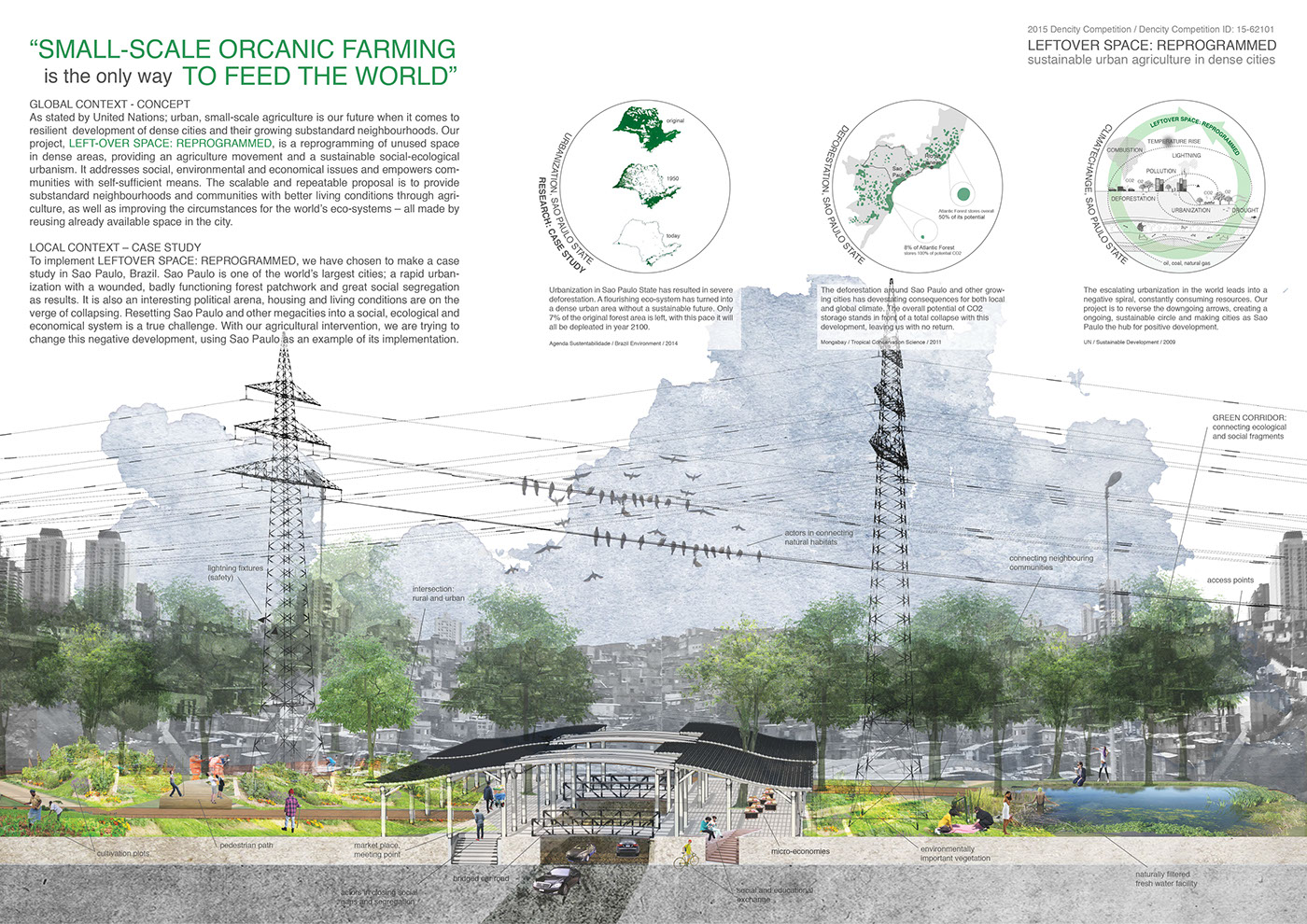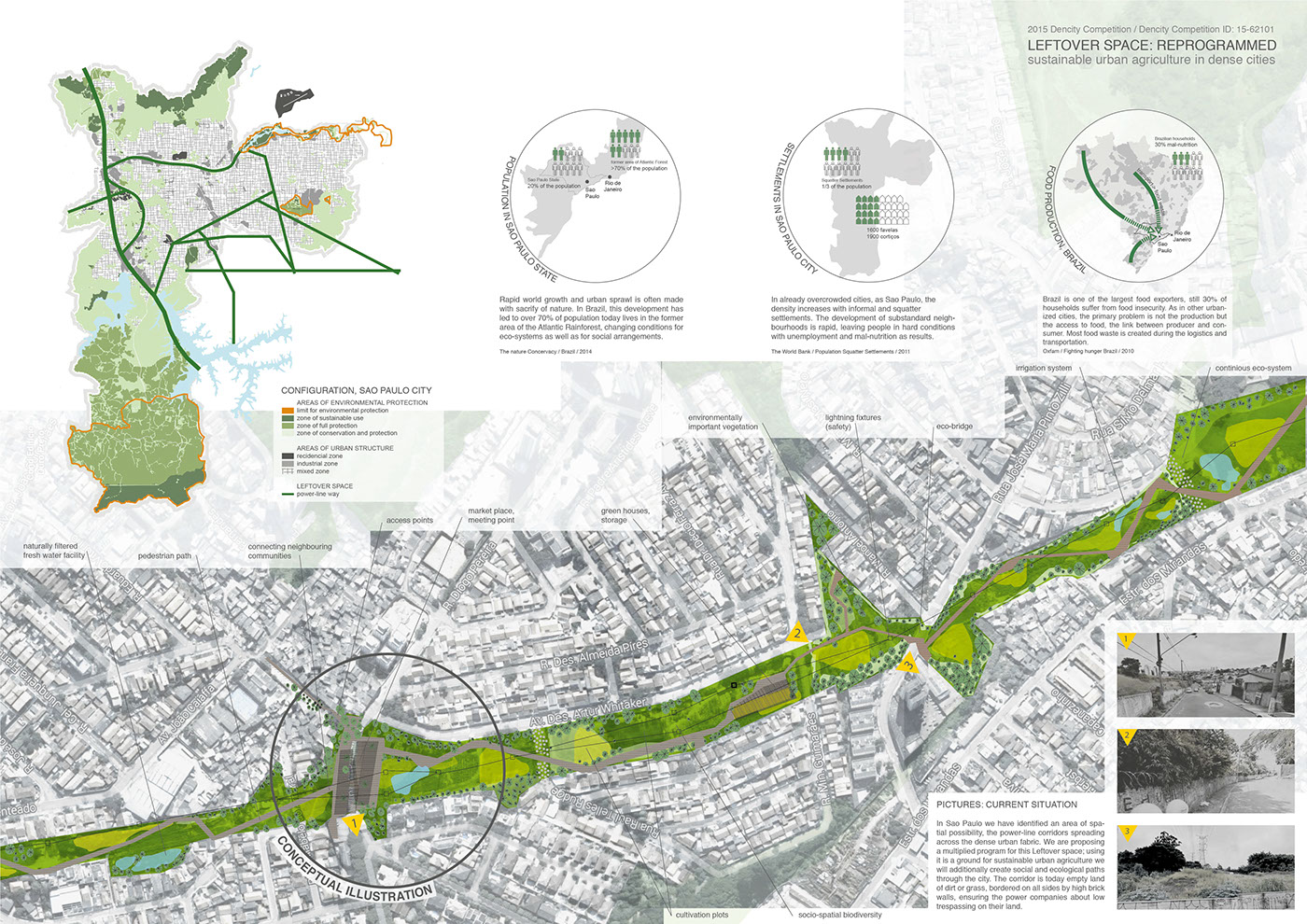SHELTER COMPETITION ENTRY 2015: Leftover Space: Reprogrammed
TEAM: Alexandra Rosengren and Rebecka Tiselius
Compitetion page: shelterglobal.org


PROJECT STATEMENT
UN report states:
“SMALL-SCALE ORCANIC FARMING is the ONLY WAY TO FEED THE WORLD”
As concluded by United Nations, urban, small-scale agriculture is our future when it comes to a resilient development of dense cities and their growing substandard neighborhoods. Our project, LEFTOVER SPACE: REPROGRAMMED, is a reprogramming of unused space in dense areas, providing an agriculture movement as well as a sustainable social-ecological urbanism. It addresses social, environmental and economical issues and empowers communities with self-sufficient means. The scalable and repeatable proposal is to provide substandard neighborhoods and communities with better living conditions through agriculture, as well as improving the circumstances for the world’s eco-systems – all made by reusing already available space in the city.
GLOBAL CONTEXT
With a scrambling urbanization, overcrowding and spreading of informal settlements, the city needs to offer even more in a constantly diminished space. To create acceptable living conditions, we have to increase the effectiveness in the city; we have to create new opportunities in already existing structures. Our idea is to multiply the functions in the urban fabric, to multiply the program of Leftover space, i.e. inhabit and use the seemingly unused space within the dense city.
Research and relevance
As the cityscape takes over the nature and more people is leaving their rural hometowns, research show that eco-systems, climate and sustainable food production is seriously threatened with growing cities. Especially people of less means suffer from mal-nutrition and our common consumption widely exceeds our production. New projection shows global food demand doubling by 2050 and increasing yield in poor countries could lower environmental impact. Therefore, ecological urban small-scale agriculture is the only sustainable way forward, encouraging environmental consciousness as well as community collaborations, employment and micro-economies. With urban agriculture in leftover spaces we want to establish a close interaction between the eco-system and the urban fabric, giving people and nature a fruitful interchange. Additionally, this concept of bringing nature back into cities is very important when it comes to the escalating climate change. More connected nature means more resilient eco-systems, a must for increasing CO2 storage and other vital natural functions.
Scaling and Repeating
Most importantly, LEFTOVER SPACE: REPROGRAMMED is a concept that could be scaled and multiplied in cities all over the world. The more coherencies, the more enhanced eco-systems and the more sustainable ecological, social and economic development.
LOCAL CONTEXT – CASE STUDY
To implement LEFTOVER SPACE: REPROGRAMMED, we have chosen to make a case study in Sao Paulo, Brazil. Sao Paulo is one of the world’s largest cities; a rapid urbanization with a wounded, badly functioning forest patchwork and great social segregation as results. It is also an interesting political arena, housing and living conditions are on the verge of collapsing, resulting in occupation movements and a widely spread social engagement. It is a perfect example of a city that is open for change, a society with hunger for new possibilities. Resetting Sao Paulo and other megacities into a social-, ecological- and economical system is a true challenge. With our agricultural intervention, we are trying to change this negative development, using Sao Paulo as an example of its implementation.
Research and relevance
Brazil is also one of the largest food exporters with capacity to meet both internal and external needs and still, 30% of the households suffer from food insecurity. As in many other urbanized countries, the primary problem is not the production but the access to food, the link between the producer and consumer. Something that also is intensified with the increased divide between rural and urban areas and the following economical and social segregation. Also interesting to note, is that the most amount of food waste is created during the logistics and transportation; another argument of the importance of bringing agriculture into the cities and closer to the population.
In already overcrowded cities, as Sao Paulo, the density increases with informal and squatter settlements. The development of substandard neighborhoods is rapid, leaving people in hard conditions with unemployment and mal-nutrition as results. Today, 1/3 of Sao Paolo’s population lives in informal settlements and there are around 1600 favelas. Furthermore, the escalating urbanization in Sao Paulo leads to a negative spiral, constantly consuming resources. To exemplify this, only 7% of what was the Atlantic Rainforest still remains. More than 70% of Brazils population now inhabits that area. Our project is to reverse the down going arrows, creating an on-going, sustainable circle and making cities as Sao Paulo the hub for positive development. Awareness of the dynamics is important for social-ecological resilience, and is often found in traditional societies with long history of managing local natural resources such as the indigenous people in the Amazons or the former Atlantic forest in Brazil.
Identified Space
Both the nature around Sao Paulo, and even the society itself, is in the power of division and fragmentation. With fragments come edges, challenging the habitats by reducing its original function and risking the possibilities of surviving. But edges are also a possibility, a junction that creates space for synergies. In Sao Paulo we have identified such an area of spatial possibility, the power-line corridors spreading across the dense urban fabric. We are proposing a multiplied program for this Leftover space; by using it is a ground for sustainable urban agriculture we will additionally create social and ecological paths through the city. It is all about creating an opportunity for the nature to work within the city, giving all its inhabitants recourses to subsist and develop collectively. The areas under redevelopment also represent fundamental opportunities to optimise integrated sustainability – environmental, economic, social, cultural, political and technological.
Reprogramming
The power-line corridor for our case study reaches from the water reservoir Tietê in the southeast, through the city centre and further along the environmental protection area of Rio Tietê in the northeast. The corridor is today only empty land of dirt or grass, bordered on all sides by high brick walls, ensuring the power companies about low trespassing on their land. In our project, the first step is to gain access to this space, typically by a rent agreement between the power company and the urban agriculture movement. Secondly, the corridor is adapted to interact with the surroundings, changing current boundaries into access points, tying neighbouring communities together with pedestrian paths and bridging interfering car roads. As the corridors will be used as a way of transportation, safety is important. Walkways are prioritized and the power-line with its poles will also be used to light up the area during the darker hours. Around the heavier power-lines, environmentally important vegetation will be planted, serving the overall eco-system and securing people from any possible electrical radiation. Around low-powered lines the cultivation plots are divided and spread according to the adjacent communities’ needs and possibilities, typically favelas or informal settlements that uses whatever space that’s left over and where the unemployment is a great issue.
Design and Configuration
The cultivation plots and their users are also connected with paths to basic farming needs, as green houses, storage and freshwater facilities; irrigation, ponds, showers etc. all made with natural techniques. Depending on the knowledge and tools provided, the farming can be done more traditionally or more experimental – i.e. vertical gardening, aquaponics. Most importantly, the crops will provide healthy food for the communities’ needs. But with experience and more efficient farming, the communities will be able to produce an excess, why also market places along this corridor is important to increase the monetary means and chances of successful micro-economies. The market place will be used as a vendor space as well as a meeting point, with both social and educational effects. It will be the interaction within the nearby area, creating exchange between different communities and groups, closing social gaps and segregation. Typically, the market is the actual intersection between the agriculture and the city, making it the perfect link between the green corridor and the crossing roads.
GENERAL CONCEPT – local goes global
In summary, the project is a contribution to future self-sufficient and sustainable food production as well as a connection where social and ecological space can emerge, where different communities can meet and interact and where the biodiversity can create synergies in the city. It is a test bed for socio-spatial diversity, where an extended social, ecological and urban system can emerge. Where agricultural interventions can contribute to a positive development in the society and for the climate. It is not tied to one special plot but rather a concept that could be multiplied in several similar places – from locally to regionally to globally – the more coherent fragments, the more enhanced eco-systems and the more sustainable development in the city and for the globe.
